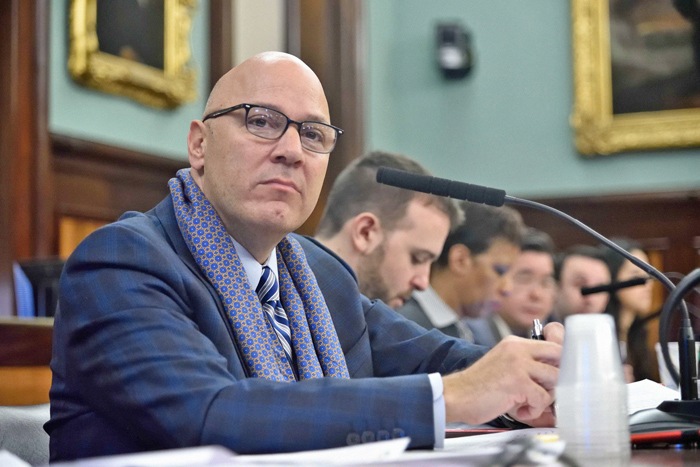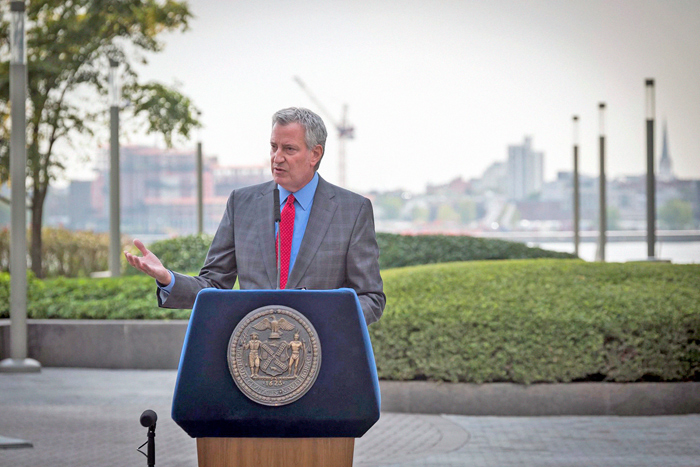Photo Courtesy of Ed Reed/Mayoral Photography Office
“New York City is about to enter a transformational era,” Mayor de Blasio said.
By Michael V. Cusenza
Citing the link between the city’s economic health and the health of New Yorkers, Mayor Bill de Blasio on Thursday released NYC’s recovery agenda, focusing on public health and social justice by setting a framework for a series of policies to address both.
The announcement will kick off a series of policy proposals, which are focused on four principles to make New York City stronger, healthier, and fairer:
- Continue the City’s momentum in fighting back COVID-19: Hizzoner pledged to continue the momentum in fighting COVID-19 by working with the private sector to expand lab capacity and deploy rapid, safe, and inexpensive testing, allowing our businesses to stay open and our economy to move forward. Last month, the City and its partners announced the opening of the Pandemic Response lab. On Thursday the City launched a competition to design rapid, reliable and inexpensive testing for COVID-19. The City will be prepared to lead in the distribution of vaccines and treatments as medical advances become available.
- Make the City a hub for public health research: “We will make New York Center a center of innovation for public health research, design, and practice,” de Blasio said. “We will build new research and development facilities and forge collaboration among unlikely partners – doctors and nurses, academic researchers, industry innovators, health nonprofits and economic development community organizations, just as we did in early days of COVID-19. Because health security depends upon a highly trained workforce, we will create a Public Health Corps – a team of community health workers building trust and taking care of people in our hardest hit neighborhoods.
- Create high-quality jobs: The City will encourage the creation of new, high-quality jobs that also help improve NYC’s health.
- Continue making New York the fairest city in America: “We will center service and action in neighborhoods that have carried the heaviest burden of economic and health inequities. The plan will include policy proposals around better use of public spaces, a more equitable transit system, and small business recovery, all of which are critical to a healthy and thriving city,” de Blasio added.

Photo Courtesy of NYCEDC
Last month, the New York City Economic Development Corporation launched the Pandemic Response Lab.
The mayor announced a competition to accelerate the development and deployment of rapid COVID tests. Submissions from participants will be evaluated based on their performance and how well they meet the following criteria: ease of use; the delivery of quick and accurate results; scalability and cost; and clarity of communication with patients and health agencies. City officials said they hope to have Rapid Tests identified via the competition in the next several months. More information can be found at http://edc.nyc/rapidtesting.
Last month, the New York City Economic Development Corporation launched the Pandemic Response Lab, a facility dedicated to processing COVID-19 tests within 24-48 hours for NYC Health + Hospitals. The lab is scaling up to process 20,000 tests per day by November, guaranteeing dedicated capacity to meet New York City’s most pressing needs.
As COVID vaccinations remain under development, the City is reviewing proposed vaccine prioritization frameworks and tailoring them to meet the City’s needs. When a vaccine is ready, New York City will have storage and distribution protocols in place—and will ensure vulnerable residents know where and how to get it, de Blasio promised.
“New York City is about to enter a transformational era,” the mayor said. “We know that our recovery begins and ends with healthcare, and we will again be a beacon to the rest of the world, rise to the challenge of setting forth a recovery that everyone can look to, and set forth a recovery plan that will work for everyone.”

“As our businesses, offices, restaurants and schools continue to reopen their doors, we must use every tool in our toolbox to renew and sustain an economic recovery in New York City,” Councilman Vallone said.
City Department of Transportation Commissioner Polly Trottenberg said, “As part of our response to COVID-19, New York City has already done so much to transform our streets to make our city healthier, more sustainable, and more economically vibrant. In the months ahead and with the mayor’s leadership, we will build on the successes of Open Streets, Open Restaurants, and now Outdoor Learning. Looking long-term, we will continue to aggressively meet New Yorkers’ demand for better bike and bus travel—safely advancing on the incredible progress that has made us a national model for recovery.”
And City Councilman Paul Vallone (D-Bayside), chairman of the Council Committee on Economic Development, added on Thursday, “As our businesses, offices, restaurants and schools continue to reopen their doors, we must use every tool in our toolbox to renew and sustain an economic recovery in New York City. Cutting red tape to better support our small businesses and restaurants, strengthening our COVID-19 testing deployment and developing and investing in our public health workforce are three important steps our city can take right now to safeguard both the health of New Yorkers and the health of our economy.”

